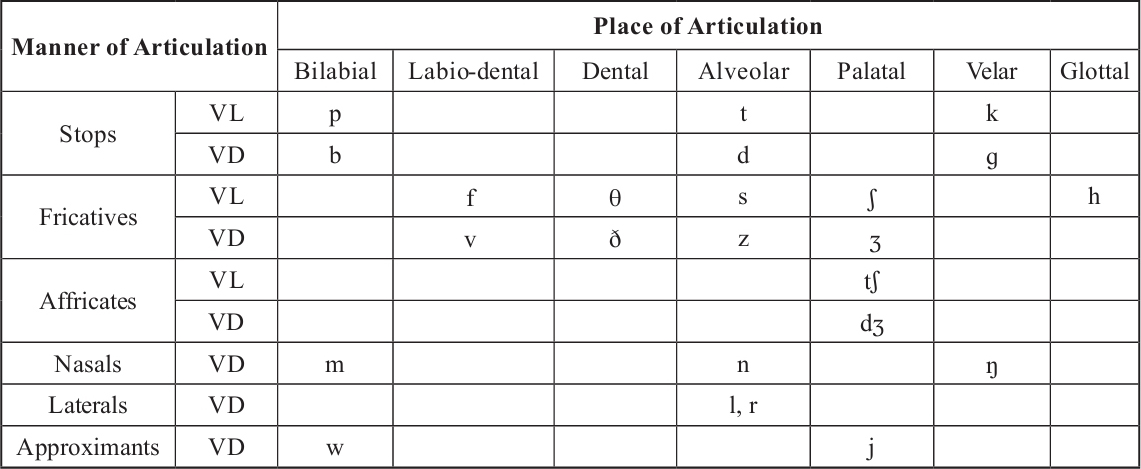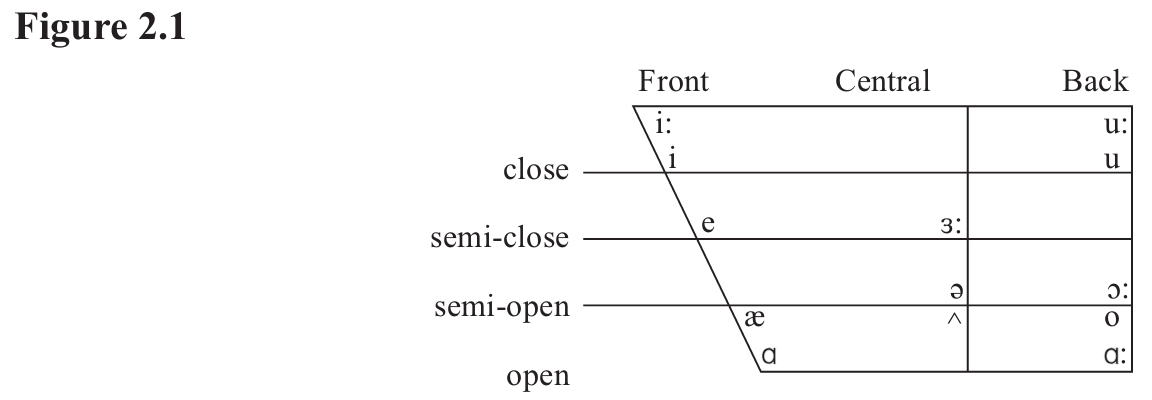





语音学的定义、三个主要研究领域;发音语音学中,发音器官的位置、特点、功能;辅音、元音的定义;辅音发音的部位和方式、辅音的分类;基本元音,元音的分类;语音标记,国际音标,宽式和严式标音法。要记住并能绘制基本元音图。
音系学的定义,音系学与语音学的联系和区别。音素、音位、音位变体、最小对立体、自由变体的定义。音位理论;音位的对立分布和互补分布、语音相似性区别性特征;超语段音位学;音节;重音和语调等。
要能够根据所学知识,解决实际语音问题,如填写单词的国际音标、用严式标音描述单词或句子的实际发音、描述音素或音位的区别性特征(或者相反,要求根据区别特征矩阵,写出相应的音位),划分单词的音节,以及寻找音位规则等。
The definition of phonetics and its three major research fields; the location, characteristic and function of the speech organs; the definitions and classifications of consonants and vowels, the places of articulation and manner of articulation, cardinal vowels, IPA, broad and narrow transcriptions and the lip positions in the pronunciation of the cardinal vowels.
The definition of phonology, the comparison and contrast between phonetics and phonology; the definitions of phone, phoneme, allophone, minimal pair and free variation; theories on phoneme, phonemic contrast and complementary distribution, features on phonetic similarity and distinction; suprasegmental features (syllables, stress, tone, etc.)
The ability to apply the knowledge to solve phonetic problems such as writing out the IPA of the given word, using narrow transcriptions to describe the actual pronunciation of words or sentences, describing the distinctive features of phone and phoneme or vice versa, dividing a word into syllables, finding out the phonological rules and so on.
(1)语音学研究世界上的语言的声音。根据语音产生和感知过程,语音学可分为三个主要领域:发音语音学、听觉语音学和声学语音学。在此我们主要关注的是发音语音学。
(2)发音器官指人体参与制造言语的部分,包括肺、气管、喉、鼻、口。
(3)国际音标 IPA。
(4)音段分为辅音和元音。发音时气流在声道某处受阻的音叫辅音。气流不受阻的音叫元音。[j]和[w]两音具有元音的发音特征却承担辅音的功能(只能出现于元音之前),因此被称为半元音或半辅音。
辅音的分类:根据发音方法,可分为塞音(或爆破音)、鼻音、擦音、(中)通音、边通音和塞擦音;根据发音部位,可分为双唇音、唇齿音、齿音、齿龈音、后齿龈音、腭音、软腭音和声门音。具有相同的发音部位和发音方法的两个辅音构成辅音对。成对的辅音以清浊区分。(参见英语辅音图)
基本元音是一套被任意定义的固定而无变化的元音,为语言的实际元音的描写提供参照。
(5)协同发音:指在实际话语过程中语音持续受邻近音影响,发生同时或重合发音的过程,分逆化协同发音和重复性协同发音。
(6)严式标音使用复杂的符号精确标记语音所有可能的细小变化,宽式标音指用简单的符号标记能把一个词与其他的词区分开来的那些音。
(1)语音学与音系学的区别。语音学研究如何制造、传递和接收语音;音系学研究语音的语言学模式,以发现语音的组成规则,解释发生的变化。两者有相当的重合。
(2)音位是语言中有区别词义功能的最小语音单位。音素是从语音的自然属性角度划分出来的最小语音单位。音位变体是同一个音位的不同变异形式,是音位在特定语音环境中的具体体现或具体代表。具有类似的语音序列且只有一个对应位置上语音不同的一对或一组单词,叫作“最小对立体”,可用以区分某种语言中能够导致词义变化的语音。
(3)在相同的语音环境中,几个音质上有差别的音素互相替换后,能够改变词的语音形式,能够区别词的意义,这几个音素就是对立的关系,具有对立关系的音素归为不同的音位,称为音位对立关系。从不出现在相同的语音环境中的音位变体称为互补分布,是音位互补关系。互补关系的音素归为同一音位。只有语音相近、互补分布两条都具备才是同一音位的变体。由于方言、习惯或者个人偏好等导致说话者的语音产生与音位分布规律无关的差异,叫作音位的自由变体。
(4)音位过程。同化指一个音具有了邻近音一部分或者全部特征的这一过程,有鼻化、齿化、腭化。同化常被当作协同发音的同义词,分逆同化、顺同化两种。音系过程是“目标”或“受影响的音段”在特定环境/语境中发生结构上的变化的过程。任何音系过程包括:A.一套由语音产生音系的过程;B.一套经历了音系过程的语音;C.音系过程得以发生的条件。
(5)超音段特征指比音位大的语音单位,如音节、重音、音高、声调和语调。音节一般由三个部分组成:节首、核心和韵尾,其中核心是必需的部分。没有韵尾的音节称为开音节,有韵尾的音节称为闭音节。英语里,只有长元音和双元音可以出现在开音节中。节首可以是空的或者最多三个辅音的辅音丛,韵尾最多可以有四个辅音。音节划分要遵守“最大节首原则”,即当选择如何划归辅音时,应该将辅音归入节首而不是韵尾。
(6)重音是指在音节发音时所用的力度。
(1)Phonetics is the study of sounds, which occurs in the world's languages.According to the process of speech production and perception, phonetics includes three branches: articulatory phonetics, auditory phonetics, and acoustic phonetics, the first of which is of our major concern.
(2)Speech organs are the human body involved in the production of speech, including the lungs, the trachea, the throat, the nose and the mouth.
(3)IPA, International Phonetic Alphabet
(4)Sound segments are grouped into consonants and vowels.Consonants are sounds produced by obstructing the flow of air in the oral cavity while vowels are produced when the air stream meets with no obstruction.The sounds [j] and [w] possess the feature of vowels but function as the consonants, thus the category semi-vowel or semi-consonant.
By manner of articulation, the English consonants can be grouped into stops, nasals, fricatives, approximants, laterals and affricates.In terms of place of articulation, consonants can be classified into bilabials, labio-dentals, dentals, alveolars, postalveolars, palatals, velars, and glottal.Two consonants sharing the same place and manner of articulation become a pair, which is distinguished by voiceless or voiced.(See the table below)
The cardinal vowels are a set of fixed and unchanging vowel qualities to provide reference for the description of the actual vowels.
(5)Coarticulation: the process of simultaneous or overlap-ping articulations when sounds show the influence of their neighbors; including anticipatory coarticulation and preservative coarticulation.
(6)The narrow transcription tries to symbolize all the pos-sible speech sounds, including even the minutest shades of pronunciation while broad transcription indicates only those sounds capable of distinguishing one word from another in a given language.
(1)Although both are related to the study of sounds, pho-netics studies the production, transmission and recep-tion of sounds while phonology focuses on the linguistic patterns of speech sounds and how they are used to convey meaning in linguistic communication.
(2)A phoneme is a phonological unit; it is a unit that is of distinctive value.A phone is a phonetic unit or segment.The speech sounds we hear and produce during linguis-tic communication are all phones.The different phones representing a phoneme in different phonetic environ-ments are called its allophones.
When two different phonetic forms are identical in every way except for one sound segment which occurs in the same place in the string, the two forms (i.e., words)are supposed to form a minimal pair, e.g.“pill” and “bill” are identical in form except for the initial consonants.
(3)If the phonetically similar sounds are two distinctive phonemes, e.g.[p] and [b] in “pit” and “bit”, they are said to form a phonemic contrast.
If they are allophones of the same phoneme, then they do not distinguish meaning, but complement each other in distribution, i.e.the clear [1] always occurs before a vowel while the dark [1] always occurs between a vowel and a consonant or at the end of a word.So the allophones are said to be in complementary distribution.If two sounds occurring in the same environment do not contrast; i.e., the substitution of one for the other does not generate a new word but merely a different pronunciation of the same word, the two sounds are said to be in “free variation”.
(4)Phonological process
The assimilation rule assimilates one sound to another by copying a feature of a sequential phoneme, thus making the two phones similar, which includes nasalization, dentalization and velarization.Phonological processes are the processes in which target or affected segment undergoes a structural change in certain environments or contexts, which include A.a set of sounds to undergo the process, B.a set of sounds produced by the process and C.a set of situations in which the process applies.
(5)Suprasegmental phonology refers to the study of phonolo-gical properties of linguistic units larger than the segment called phoneme, such as syllable, stress, pitch, tone and intonation.A syllable can be divided into onset, nucleus and coda, of which nucleus is a must.A syllable that has no coda is called an open syllable while a syllable with coda is called a closed syllable.In English only long vowels and diphthongs can occur in open syllables.The onset may be empty or filled by a cluster of as many as three consonants, while the coda position may be filled by as many as four consonants.The maximal onset principle states that when there is a choice as to where to place a consonant, it is put into the onset rather than the coda.
(6)Stress refers to the degree of force used in producing a syllable.
Table 2.1 A chart of English consonants

①舌头抬起的高度(前央后)
②舌头最高部分的位置(高中低)
③嘴的开合度(合、半合、半开、开)
④唇的圆展度(圆唇、非圆唇)
⑤发音的长度(紧、松)
①the part of the tongue that is raised—front, center or back
②the height of the tongue—high, middle, low
③the opening of the mouth—close, semi-close, semi-open, open
④the shape of the lips—rounded, unrounded
⑤the length of the sound—tense, lax

Tongue positions of the cardinal vowels